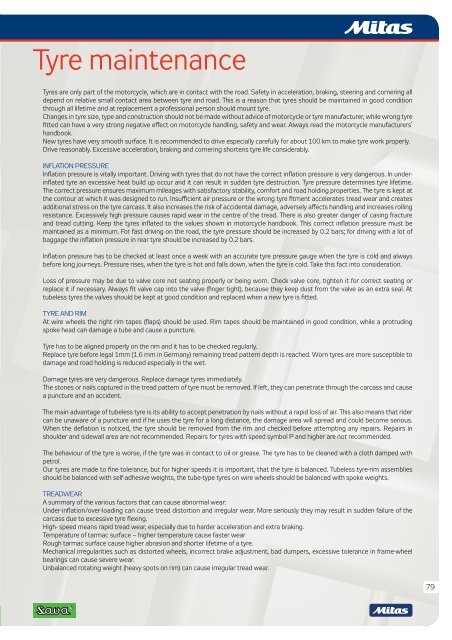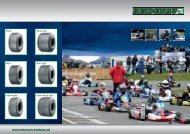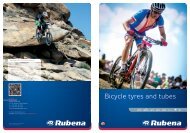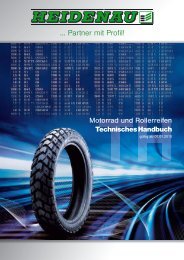Tyres and tubes
Tyres and tubes - Gumaker
Tyres and tubes - Gumaker
- No tags were found...
You also want an ePaper? Increase the reach of your titles
YUMPU automatically turns print PDFs into web optimized ePapers that Google loves.
Tyre maintenance<br />
<strong>Tyres</strong> are only part of the motorcycle, which are in contact with the road. Safety in acceleration, braking, steering <strong>and</strong> cornering all<br />
depend on relative small contact area between tyre <strong>and</strong> road. This is a reason that tyres should be maintained in good condition<br />
through all lifetime <strong>and</strong> at replacement a professional person should mount tyre.<br />
Changes in tyre size, type <strong>and</strong> construction should not be made without advice of motorcycle or tyre manufacturer, while wrong tyre<br />
fitted can have a very strong negative effect on motorcycle h<strong>and</strong>ling, safety <strong>and</strong> wear. Always read the motorcycle manufacturers’<br />
h<strong>and</strong>book.<br />
New tyres have very smooth surface. It is recommended to drive especially carefully for about 100 km to make tyre work properly.<br />
Drive reasonably. Excessive acceleration, braking <strong>and</strong> cornering shortens tyre life considerably.<br />
Inflation pressure<br />
Inflation pressure is vitally important. Driving with tyres that do not have the correct inflation pressure is very dangerous. In underinflated<br />
tyre an excessive heat build up occur <strong>and</strong> it can result in sudden tyre destruction. Tyre pressure determines tyre lifetime.<br />
The correct pressure ensures maximum mileages with satisfactory stability, comfort <strong>and</strong> road holding properties. The tyre is kept at<br />
the contour at which it was designed to run. Insufficient air pressure or the wrong tyre fitment accelerates tread wear <strong>and</strong> creates<br />
additional stress on the tyre carcass. It also increases the risk of accidental damage, adversely affects h<strong>and</strong>ling <strong>and</strong> increases rolling<br />
resistance. Excessively high pressure causes rapid wear in the centre of the tread. There is also greater danger of casing fracture<br />
<strong>and</strong> tread cutting. Keep the tyres inflated to the values shown in motorcycle h<strong>and</strong>book. This correct inflation pressure must be<br />
maintained as a minimum. For fast driving on the road, the tyre pressure should be increased by 0.2 bars; for driving with a lot of<br />
baggage the inflation pressure in rear tyre should be increased by 0.2 bars.<br />
Inflation pressure has to be checked at least once a week with an accurate tyre pressure gauge when the tyre is cold <strong>and</strong> always<br />
before long journeys. Pressure rises, when the tyre is hot <strong>and</strong> falls down, when the tyre is cold. Take this fact into consideration.<br />
Loss of pressure may be due to valve core not seating properly or being worn. Check valve core, tighten it for correct seating or<br />
replace it if necessary. Always fit valve cap into the valve (finger tight), because they keep dust from the valve as an extra seal. At<br />
tubeless tyres the valves should be kept at good condition <strong>and</strong> replaced when a new tyre is fitted.<br />
Tyre <strong>and</strong> rim<br />
At wire wheels the right rim tapes (flaps) should be used. Rim tapes should be maintained in good condition, while a protruding<br />
spoke head can damage a tube <strong>and</strong> cause a puncture.<br />
Tyre has to be aligned properly on the rim <strong>and</strong> it has to be checked regularly.<br />
Replace tyre before legal 1mm (1.6 mm in Germany) remaining tread pattern depth is reached. Worn tyres are more susceptible to<br />
damage <strong>and</strong> road holding is reduced especially in the wet.<br />
Damage tyres are very dangerous. Replace damage tyres immediately.<br />
The stones or nails captured in the tread pattern of tyre must be removed. If left, they can penetrate through the carcass <strong>and</strong> cause<br />
a puncture <strong>and</strong> an accident.<br />
The main advantage of tubeless tyre is its ability to accept penetration by nails without a rapid loss of air. This also means that rider<br />
can be unaware of a puncture <strong>and</strong> if he uses the tyre for a long distance, the damage area will spread <strong>and</strong> could become serious.<br />
When the deflation is noticed, the tyre should be removed from the rim <strong>and</strong> checked before attempting any repairs. Repairs in<br />
shoulder <strong>and</strong> sidewall area are not recommended. Repairs for tyres with speed symbol P <strong>and</strong> higher are not recommended.<br />
The behaviour of the tyre is worse, if the tyre was in contact to oil or grease. The tyre has to be cleaned with a cloth damped with<br />
petrol.<br />
Our tyres are made to fine tolerance, but for higher speeds it is important, that the tyre is balanced. Tubeless tyre-rim assemblies<br />
should be balanced with self-adhesive weights, the tube-type tyres on wire wheels should be balanced with spoke weights.<br />
Treadwear<br />
A summary of the various factors that can cause abnormal wear:<br />
Under-inflation/over-loading can cause tread distortion <strong>and</strong> irregular wear. More seriously they may result in sudden failure of the<br />
carcass due to excessive tyre flexing.<br />
High- speed means rapid tread wear, especially due to harder acceleration <strong>and</strong> extra braking.<br />
Temperature of tarmac surface – higher temperature cause faster wear<br />
Rough tarmac surface cause higher abrasion <strong>and</strong> shorter lifetime of a tyre.<br />
Mechanical irregularities such as distorted wheels, incorrect brake adjustment, bad dumpers, excessive tolerance in frame-wheel<br />
bearings can cause severe wear.<br />
Unbalanced rotating weight (heavy spots on rim) can cause irregular tread wear.<br />
79





